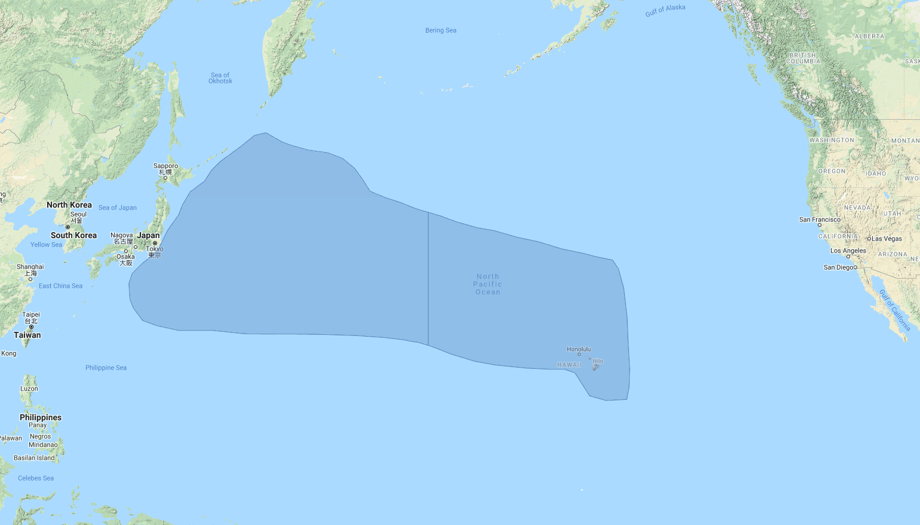Birdfinding.info ⇒ Locally common around its nesting islands, especially from November to May, and to a lesser extent year-round. Most of these sites are remote, but the Izu Islands are accessible by ferry from Tokyo and Shimodo. In June and July, post-breeders are often seen farther north offshore from eastern Honshu. In Hawaii it breeds in the Northwest Chain but has rarely been reported from the main islands, with most accepted records from February to April in offshore waters west or north of Kauai. A breeding colony formed by the translocation of chicks to James Campbell National Wildlife Refuge has shown initial signs of becoming established, which may increase viewing opportunities around Oahu.
Tristram’s Storm-Petrel
Hydrobates tristrami
Breeds on offshore islands of Japan and the Northwest Chain of Hawaii. Disperses to the subtropical western North Pacific.
Breeding. Breeds from November to May on Japan’s Izu, Torishima, Ogasawara, and Iwo Islands, and the Northwest Chain of Hawaii.
Most of the Izu population, ~760 pairs, nests on Tadanae-jima (an islet east of Kozu-shima), with about twenty pairs on Hachijyo-kojima (an islet west of Hachijyo-jima).
In the Northwest Chain, the largest colonies are on Nihoa (~3,000 pairs) and Laysan (~2,000). Also nests on Kure, Midway, Pearl and Hermes Reefs, and French Frigate Shoals, and suspected on Necker and Lisianski.
In the main Hawaiian Islands, a new breeding colony might become established at James Campbell National Wildlife Refuge on the north shore of Oahu. In 2018, conservation biologists began translocating newly-hatched chicks from the Northwest Chain. In subsequent years, some of those individuals have returned, and eventual formation of a colony there appears likely.
Nonbreeding. Partly resident in the vicinity of nesting islands. Some portion of the Japanese population disperses north to waters east of Honshu.
Three records from California—one on April 22, 2006, mist-netted at Southeast Farallon Island and at-sea observations in July 2007 and 2018 in southern California waters—suggest that small numbers may wander regularly to the eastern North Pacific.

Tristram’s Storm-Petrel, inexplicably in the wrong ocean. (Offshore from Sydney, Australia; October 9, 2000.) © Tony Palliser
Farther afield, there are exceptional records from southwestern Taiwan (July 31, 2005) and offshore from Sydney, Australia (October 9, 2000).
Identification
A large, dark-brown storm-petrel with prominent blond carpal bars on the wing coverts, variably pale rump, and a long, deeply forked tail.
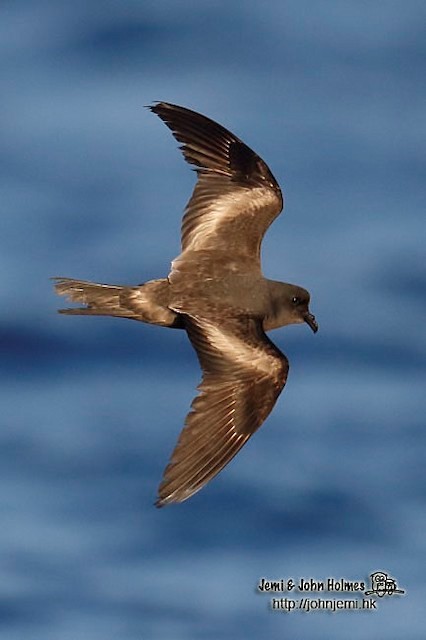
Tristram’s Storm-Petrel, showing characteristically bold blond carpal bars and rump band. (Offshore from Iwo Jima, Ogasawara Islands, Japan; May 9, 2015.) © Jemi & John Holmes
Generally has the most pronounced carpal bars of any storm-petrel, but a few others are similar (especially Markham’s, Black, and Swinhoe’s; see below).
The rump is neither white nor dark—it usually appears paler than the back and tail, not as pale as the carpal bars but often close to the same tone. The paler area is often U-shaped, sometimes divided.
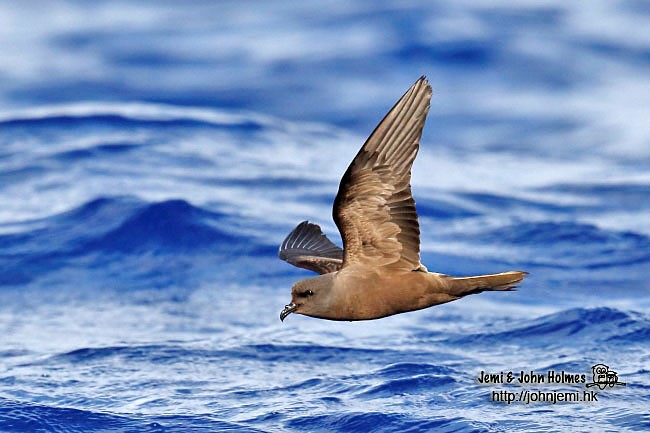
Tristram’s Storm-Petrel, showing subtly blacker hood. (Offshore from Iwo Jima, Ogasawara Islands, Japan; May 9, 2015.) © Jemi & John Holmes
Often shows a darker, blackish hood that contrasts with paler, more grayish-brown back and warm-brown chest.
Flight is steady and stable, with wings crooked slightly at the wrist, more similar to some gadfly petrels than to most storm-petrels.
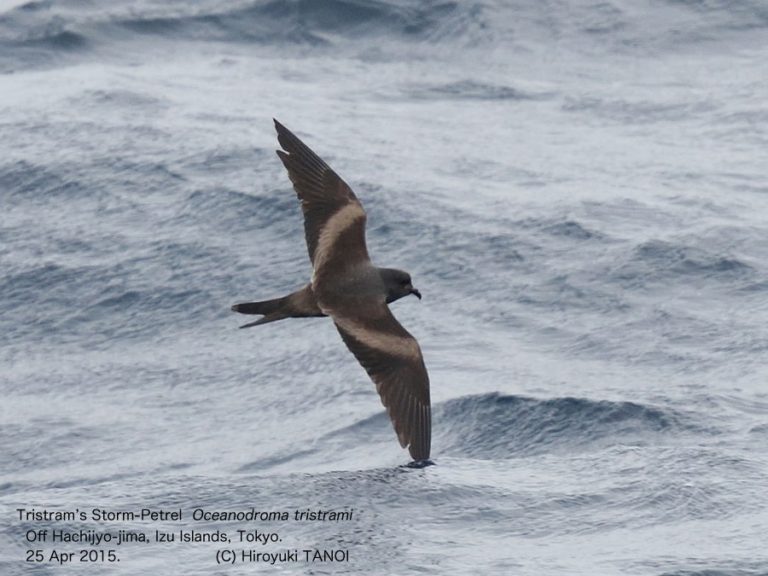
Tristram’s Storm-Petrel, showing characteristically bold blond carpal bars, subtle rump band, and deeply forked tail. (Offshore from Hachijyo-jima, Izu Islands, Japan; April 25, 2015.) © Hiroyuki Tanoi
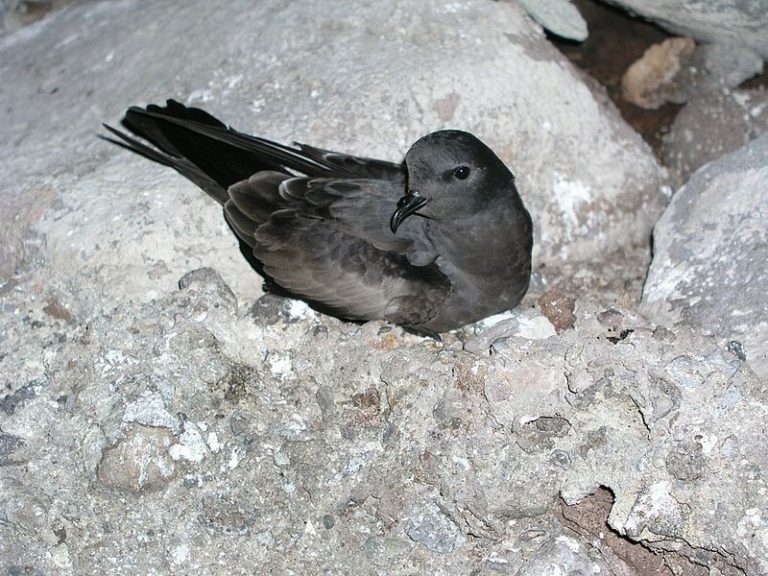
Tristram’s Storm-Petrel. (Nihoa Island, Hawaii; April 12, 2016.) U.S. Fish & Wildlife Service
Notes
Monotypic species.
See below for comparisons of Tristram’s Storm-Petrel with Markham’s, Black, Swinhoe’s, Matsudaira’s, Ashy, Townsend’s, and other dark-rumped, medium-sized storm-petrels.
Cf. Markham’s Storm-Petrel. Tristram’s and Markham’s are large, dark storm-petrels with nearly identical plumages. They are not known to overlap but recorded occurrences have approached one another in waters of California and Mexico. Both are large, but Tristram’s is larger and flies more heavily. Both have pronounced carpal bars, but Tristram’s’ is somewhat more pronounced—a little wider, longer and brighter. The most objective plumage difference is the rump: dark on Markham’s versus somewhat pale on Tristram’s.
Cf. Black Storm-Petrel. Tristram’s and Black are large, dark storm-petrels that can have nearly identical plumages. They overlap at least occasionally in California waters. Both are large, but Tristram’s is larger. Their typical flight patterns differ: Black glides more and shows less effort than Tristram’s. Both can show a pronounced carpal bar—Tristram’s always has this, whereas Black’s depends on molt-stage. In all cases, Tristram’s has a more pronounced carpal bar, significantly wider, longer and brighter than Black’s. Their rumps also differ: dark on Black versus somewhat pale on Tristram’s.
Cf. Swinhoe’s Storm-Petrel. Tristram’s and Swinhoe’s are large, dark storm-petrels with nearly identical plumages. They overlap widely in the western North Pacific. Both are large, but Tristram’s is larger. Their typical flight patterns differ: Swinhoe’s glides more and shows less effort than Tristram’s. Both can show a pronounced carpal bar—Tristram’s always has this, Swinhoe’s less consistently, likely dependent on molt-stage. The uppersides of their wings also differ in that Swinhoe’s usually has noticeable white flashes in the primary shafts. Their rumps also differ: dark on Swinhoe’s versus somewhat pale on Tristram’s.
Cf. Matsudaira’s Storm-Petrel. Tristram’s and Matsudaira’s are large, dark storm-petrels with similar plumages. They overlap widely in the western North Pacific. A clear view of the upperside of the wings is usually sufficient to distinguish them: Matsudaira’s has a somewhat less pronounced carpal bar than Tristram’s and a strong white crescent at the base of its primaries, which is absent from Tristram’s. Although their overall measurements (length and wingspan) are about the same, they are differently proportioned: Matsudaira’s is also somewhat longer-tailed and smaller-bodied.
Cf. Ashy, Townsend’s and other dark-rumped, medium-sized storm-petrels. Tristram’s could be mistaken for Ashy, Townsend’s, “Chapman’s”, or dark-rumped Leach’s Storm-Petrels, all of which can show pronounced blond carpal bars and either dark or intermediate-colored rumps under some conditions. Tristram’s is much larger than the others in this group and has a comparatively bulky, bull-headed appearance. (See side-by-side size and shape comparison of Tristram’s and “Chapman’s” in photos below.) Its comparative heaviness also leads to differences in flight pattern: Tristram’s flies like a gadfly petrel with quick wingbeats and short glides.
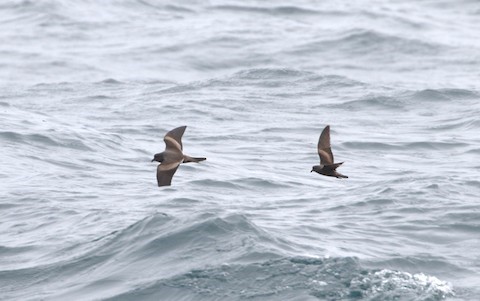
Tristram’s (at left) and Leach’s (“Chapman’s”) Storm-Petrels, showing size and shape differential. (Santa Cruz Basin, California; July 15, 2018.) © Joel Barrett
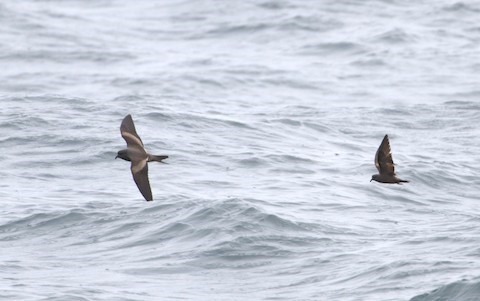
Tristram’s (at left) and Leach’s (“Chapman’s”) Storm-Petrels, showing size and shape differential. (Santa Cruz Basin, California; July 15, 2018.) © Joel Barrett
More Images of Tristram’s Storm-Petrel
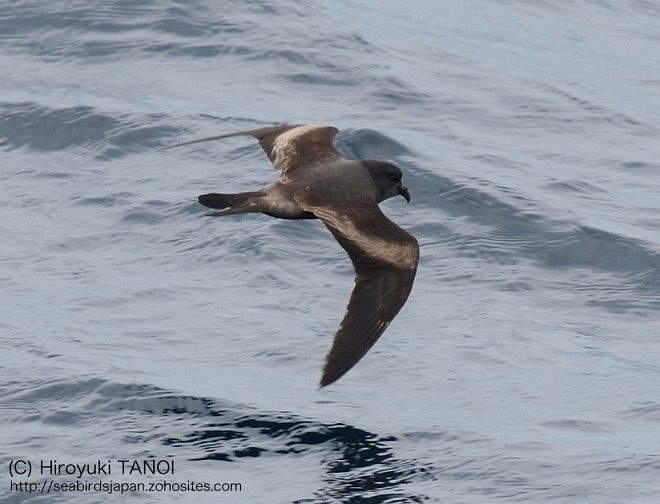
Tristram’s Storm-Petrel, showing characteristically bold blond carpal bars and rump band. (Offshore from Hachijyo-jima, Izu Islands, Japan; April 25, 2015.) © Hiroyuki Tanoi

Tristram’s Storm-Petrel. (~35km offshore from Miyako, Honshu, Japan; July 14, 2018.) © Yann Muzika

Tristram’s Storm-Petrel. (Offshore from Hachijyo-jima, Izu Islands, Japan; April 25, 2015.) © Hiroyuki Tanoi
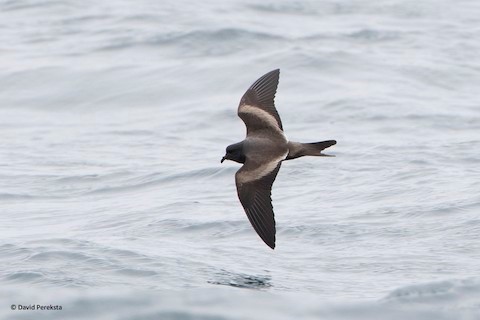
Tristram’s Storm-Petrel. (Santa Cruz Basin, California; July 15, 2018.) © David Pereksta
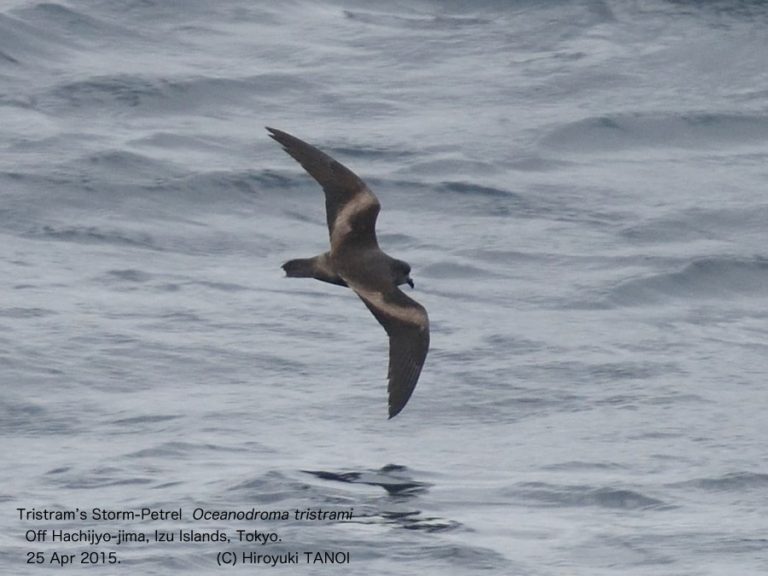
Tristram’s Storm-Petrel, with tail folded tightly. (Offshore from Hachijyo-jima, Izu Islands, Japan; April 25, 2015.) © Hiroyuki Tanoi
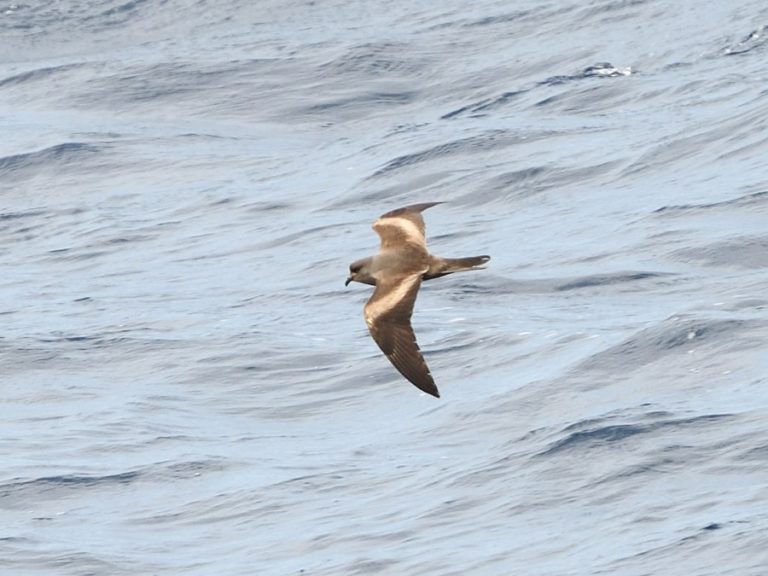
Tristram’s Storm-Petrel. (Offshore from Mukojima, Ogasawara Islands, Japan; April 11, 2019.) © Hiroyuki Tanoi
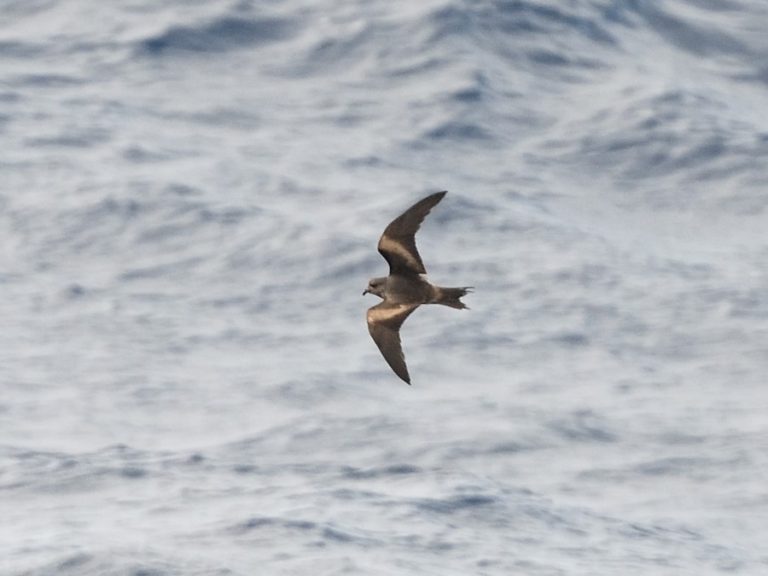
Tristram’s Storm-Petrel, showing heavy feather-wear. (Offshore from Mukojima, Ogasawara Islands, Japan; April 11, 2019.) © Hiroyuki Tanoi
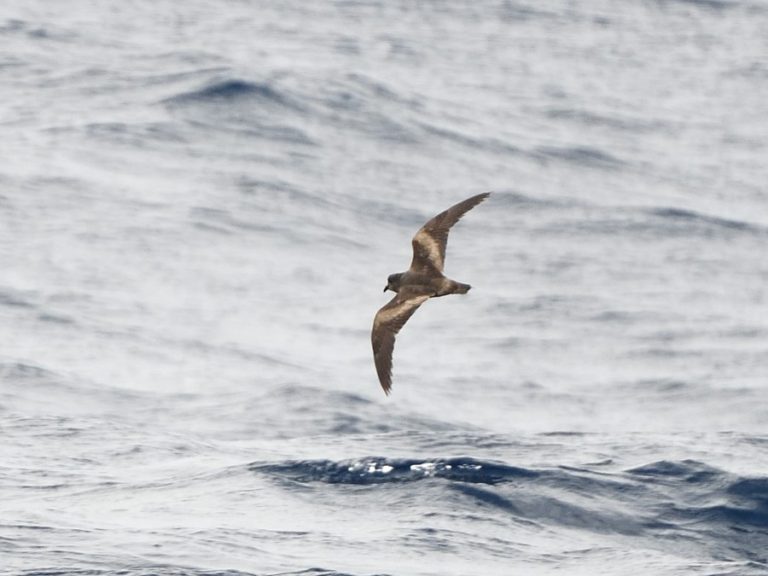
Tristram’s Storm-Petrel, with tail folded tightly. (Offshore from Mukojima, Ogasawara Islands, Japan; April 11, 2019.) © Hiroyuki Tanoi
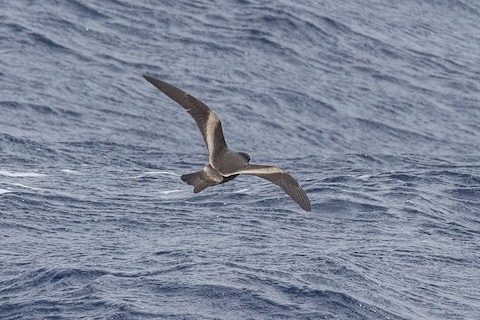
Tristram’s Storm-Petrel. (West of Ni’ihau, Hawaii; March 27, 2020.) © Eric VanderWerf
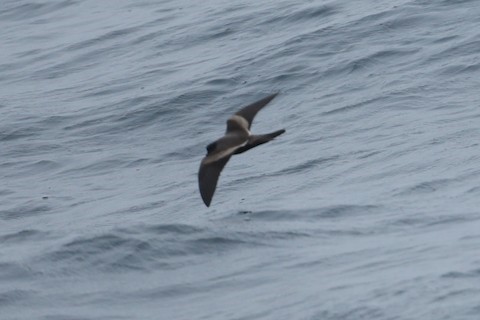
Tristram’s Storm-Petrel. (Santa Cruz Basin, California; July 15, 2018.) © Aaron Maizlish
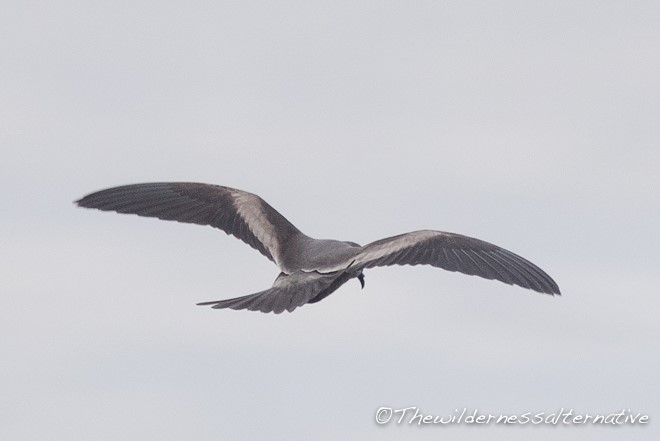
Tristram’s Storm-Petrel. (~35km offshore from Miyako, Honshu, Japan; July 14, 2018.) © Yann Muzika
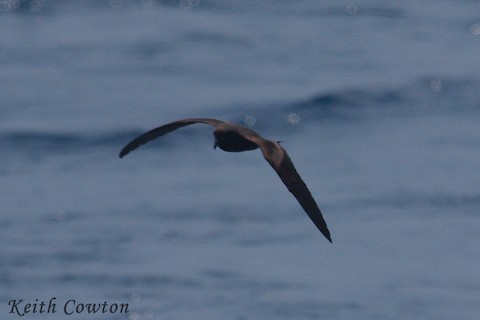
Tristram’s Storm-Petrel. (Offshore from the Ogasawara Islands, Japan; May 3, 2015.) © Keith Cowton
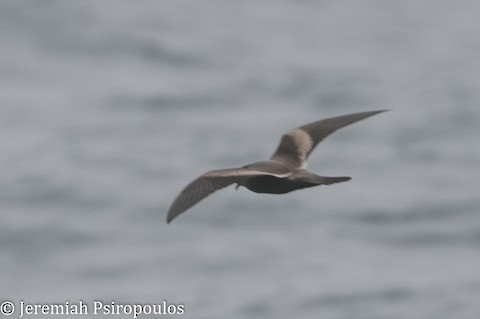
Tristram’s Storm-Petrel. (Santa Cruz Basin, California; July 15, 2018.) © Jeremiah Psiropoulos

Tristram’s Storm-Petrel. (Offshore from Fukushima, Honshu, Japan; August 3, 2017.) © Noam Markus

Tristram’s Storm-Petrel. (Santa Cruz Basin, California; July 15, 2018.) © David Pereksta

Tristram’s Storm-Petrel. (Santa Cruz Basin, California; July 15, 2018.) © Niels Lameijer

Tristram’s Storm-Petrel, juvenile (as reported by the photographer). © Hiroyuki Tanoi
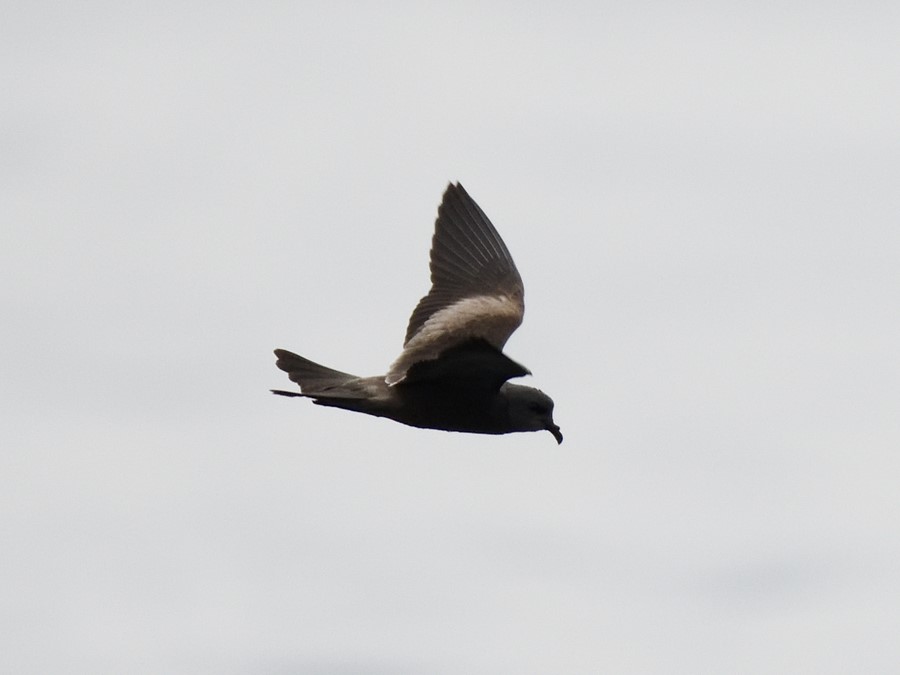
Tristram’s Storm-Petrel, juvenile (as reported by the photographer). © Hiroyuki Tanoi
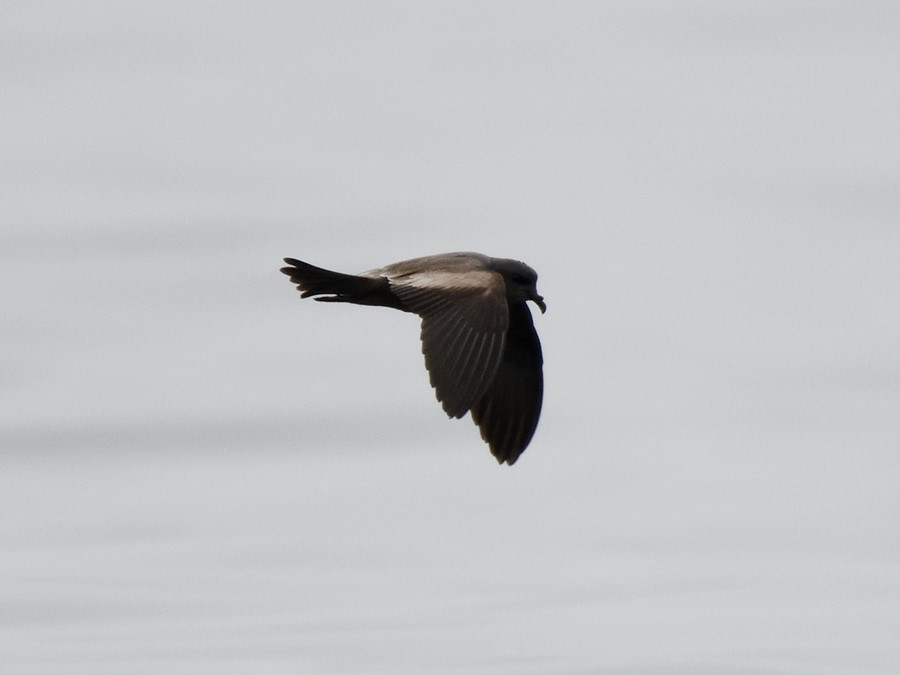
Tristram’s Storm-Petrel, juvenile (as reported by the photographer). © Hiroyuki Tanoi
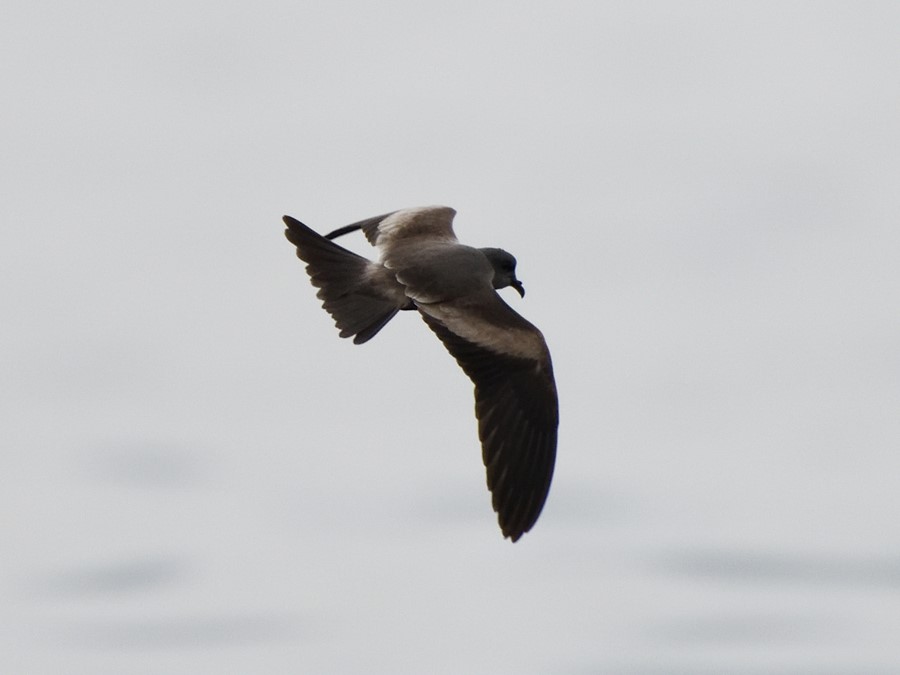
Tristram’s Storm-Petrel, juvenile (as reported by the photographer). © Hiroyuki Tanoi

Tristram’s Storm-Petrel, juvenile (as reported by the photographer). © Hiroyuki Tanoi
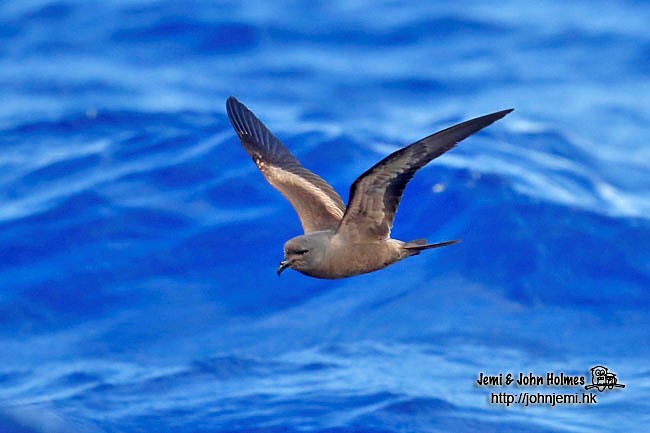
Tristram’s Storm-Petrel. (Offshore from Iwo Jima, Ogasawara Islands, Japan; May 9, 2015.) © Jemi & John Holmes

Tristram’s Storm-Petrel. (~35km offshore from Miyako, Honshu, Japan; July 14, 2018.) © Yann Muzika
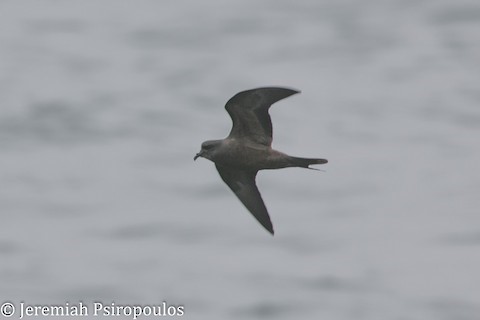
Tristram’s Storm-Petrel. (Santa Cruz Basin, California; July 15, 2018.) © Jeremiah Psiropoulos
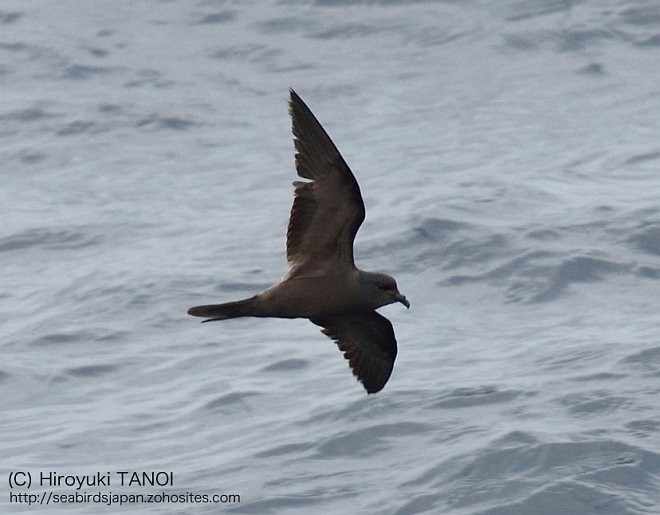
Tristram’s Storm-Petrel. (Offshore from Hachijyo-jima, Izu Islands, Japan; April 25, 2015.) © Hiroyuki Tanoi
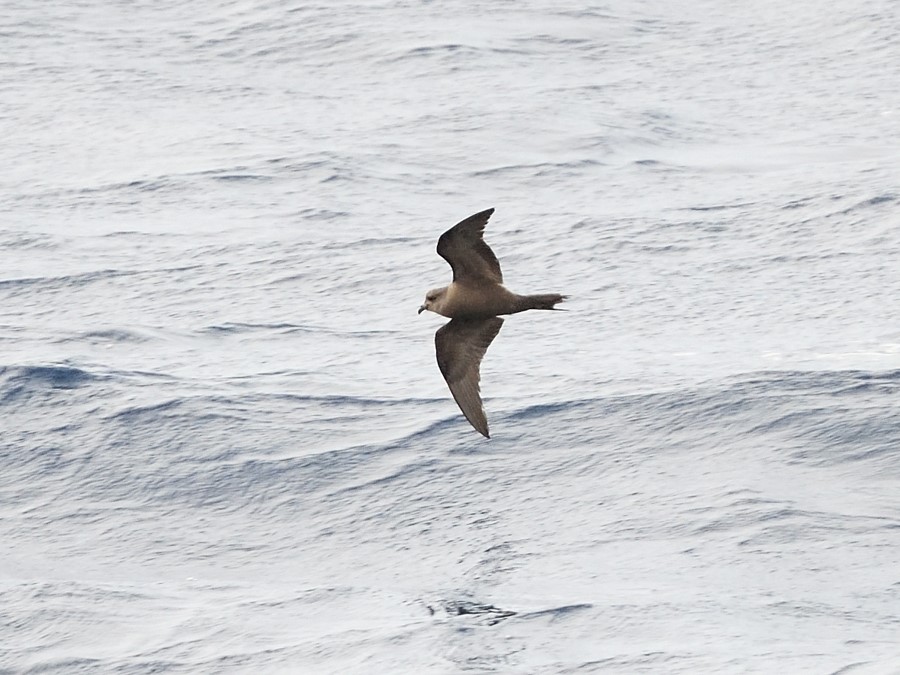
Tristram’s Storm-Petrel. (Offshore from Mukojima, Ogasawara Islands, Japan; April 11, 2019.) © Hiroyuki Tanoi

Tristram’s Storm-Petrel. (Offshore from Hachijyo-jima, Izu Islands, Japan; April 25, 2015.) © Hiroyuki Tanoi

Tristram’s Storm-Petrel, pair in nest-box. (French Frigate Shoals, Hawaii; October 30, 2006.) © Cory Gregory
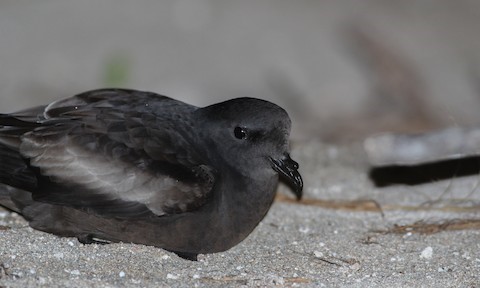
Tristram’s Storm-Petrel. (Laysan Island, Hawaii; November 9, 2011.) © Cameron Rutt
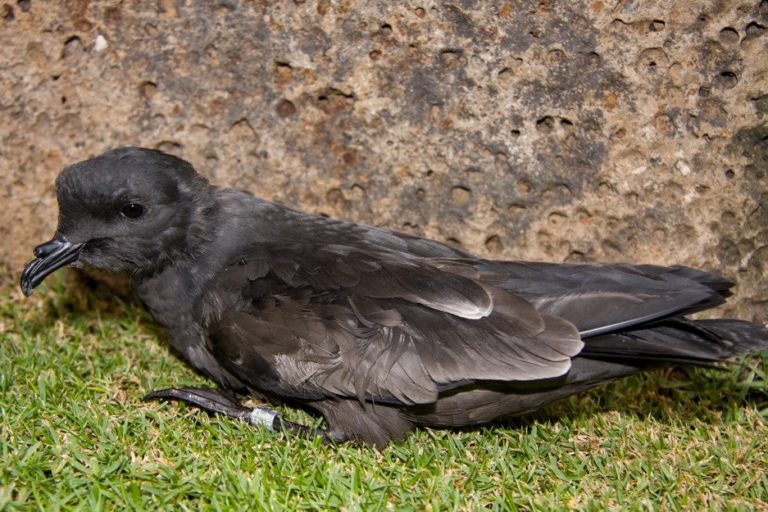
Tristram’s Storm-Petrel, juvenile. (Kualoa Beach Park, Oahu, Hawaii; April 12, 2010.) © Eric VenderWerf
References
BirdLife International. 2019. Hydrobates tristrami. The IUCN Red List of Threatened Species 2019: e.T22698535A155161970. https://dx.doi.org/10.2305/IUCN.UK.2019-3.RLTS.T22698535A155161970.en. (Accessed November 21, 2020.)
Brazil, M. 2009. Birds of East Asia. Princeton University Press.
eBird. 2020. eBird: An online database of bird distribution and abundance. Cornell Lab of Ornithology, Ithaca, N.Y. http://www.ebird.org. (Accessed November 21, 2020.)
Harrison, P. 1983. Seabirds: An Identification Guide. Houghton Mifflin, Boston.
Howell, S.N.G. 2012. Petrels, Albatrosses & Storm-Petrels of North America. Princeton University Press.
Howell, S.N.G., and K. Zufelt. 2019. Oceanic Birds of the World. Princeton University Press.
Pratt, H.D., P.L. Bruner, and D.G. Berrett. 1987. A Field Guide to the Birds of Hawaii and the Tropical Pacific. Princeton University Press.
Pyle, R.L., and P. Pyle. 2017. The Birds of the Hawaiian Islands: Occurrence, History, Distribution, and Status. Version 2 (January 1, 2017). http://hbs.bishopmuseum.org/birds/rlp-monograph/. B.P. Bishop Museum, Honolulu, Hawaii.
Seabirding of Japan. 2020. Tristram’s Storm-Petrel. http://seabirding-japan.com/tristrams-storm-petrel/. (Accessed November 21, 2020.)
Wu, N. 2021. 1st wild Bonin petrels fledged from their nests on Oahu’s North Shore. https://www.staradvertiser.com/2021/08/03/breaking-news/1st-wild-bonin-petrels-fledged-from-their-nests-on-oahus-north-shore/. Star Advertiser. (Posted August 3, 2021.)
Xeno-Canto. 2020. Tristram’s Storm Petrel – Oceanodroma tristrami. https://www.xeno-canto.org/species/Oceanodroma-tristrami. (Accessed November 22, 2020.)

